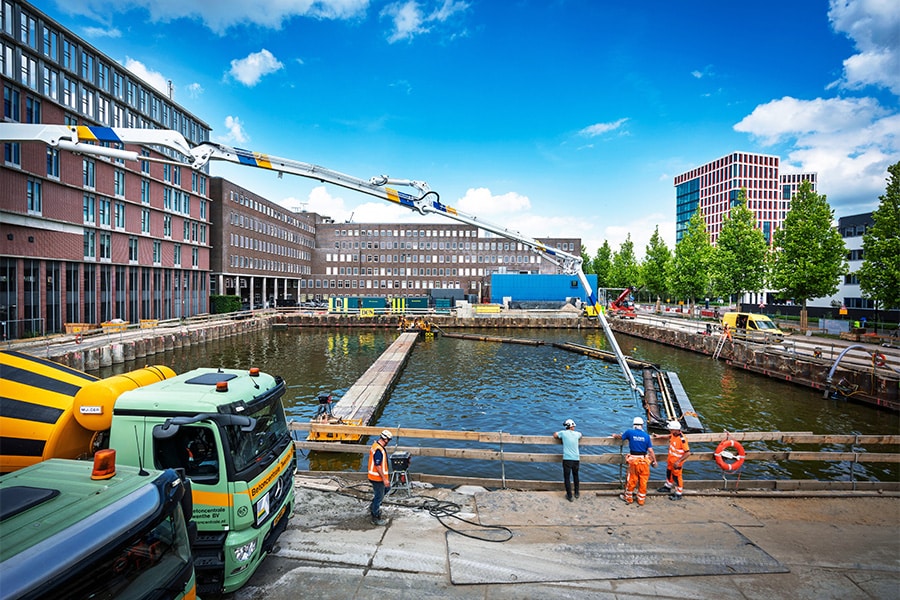
Complex construction site for new Almelo courthouse
Underwater concrete floor with steel fibers
With the driving of the first pile on Jan. 13, 2025, the construction of the new Almelo courthouse has officially begun. The new courthouse, rising right next to the train station, promises to be a striking landmark for the city. But before it gets there, several challenges must be settled. Last June, an important milestone was achieved in the complex construction pit: the pouring of the underwater concrete floor reinforced with steel fibers.
Rechtbank Overijssel has three locations, of which Almelo was in urgent need of renovation. The current building no longer met contemporary security requirements and could not be operated sustainably. “The old building was outdated, but it was essential that the court remain in Almelo,” explains Ronald Rientjes, project manager at the Rijksvastgoedbedrijf (RVB). In 2018, the decision was therefore made to build a new courthouse. The choice fell on a plot belonging to the former textile manufacturer Ten Cate, right next to the current location. After a careful process, the tender was completed in 2023 and Dura Vermeer Bouw Hengelo was awarded the contract. The new building will be some 10,000 m² in size, with space for about two hundred workstations, ten smaller courtrooms and two large halls with public galleries. There will also be a 2,000 m² parking garage and an underground cell complex. Completion is scheduled for early 2028.

A complex construction site
Below ground level lies one of the project's biggest technical challenges: the construction pit. “Here we are in the middle of the city, surrounded by the existing court, the Tax Office and the railway station,” says Peter Beijleveld, underground construction specialist at Dura Vermeer. “The trick was to come up with a construction that does not have a negative impact on the groundwater level and therefore does not pose any risks to the surroundings.” Therefore, an innovative approach was chosen with sheet pile walls eleven to fourteen meters deep and an underwater concrete floor almost one meter thick, reinforced with steel fibers. “Normally such a floor is provided with traditional reinforcement, but at a depth of six meters this is almost impossible,” explains Beijleveld. Thanks to steel fibers, the floor became stronger, more watertight and thinner: about ninety instead of 120 centimeters. This not only resulted in more ease of construction, but also a significant reduction in concrete consumption: about 1,500 m³ less. The pouring of the floor was an operation in itself. Concrete was poured continuously for almost 48 hours, using a floating ‘float’ that spread the mixture evenly. “Everything had to connect wet-in-wet and that requires extreme precision, especially in changing weather conditions. It was exciting, but the result is excellent. No cracks, nothing.”

Smart choices in design and execution
For Dura Vermeer Hengelo, this project means working in their own region, as the Hengelo construction company is only twelve kilometers away. Project manager Ruud Damhuis emphasizes the pride: “We are not building the biggest project in our history, but one of the most special. The challenges are in the construction pit, facade and finishing. And we are doing it in close collaboration with partners and architect Paul de Ruiter.” The design is both authoritative and accessible, in keeping with the local atmosphere. References to Almelo's textile history were deliberately chosen. In the courtrooms, textile wall coverings of oak and recycled PET felt are used, which not only improves the acoustics but also creates a cultural link to the city's past. The facade will also be an eye-catcher: slender concrete elements, combined with aluminum curtain walls and sustainable wood that is recessed for a warm look. “We wanted a building that is representative and sustainable and that also remains beautiful in the long term,” Rientjes said.

Remountable
Sustainability plays a central role in the design and construction. The building almost meets Paris Proof standards and scores high in the MPG. There will be thermal storage, solar panels and triple glazing. In the construction, too, solutions have been sought that are remountable: components such as steel structures and hollow-core slabs can easily be reused in the future, according to Damhuis. “The construction site has also been designed as sustainably as possible. For example, we work with fully electric cranes and the limited power capacity is cleverly utilized with battery storage. Power is supplied to the construction site during the day, while batteries are charged at night to avoid diesel generators.’
Close cooperation
The process from design to execution was characterized by close cooperation between the RVB, the court and Dura Vermeer. “By dividing the project into two tracks - a team for the construction pit and a team for the further design - time could be saved and coordination with users was optimally organized,” says Damhuis. For Rientjes, the result is promising: “We have realized large courts before, such as in Amsterdam, but this smaller scale and local anchoring make Almelo unique. It will be a building that speaks the language of the city.” Damhuis concurs: “For us, this is a project close to home, with a lot of pride and commitment. It is not a standard task, but one that calls for inventiveness and cooperation. That is precisely what makes it special.”
If everything goes according to plan, the new courthouse can be inaugurated in early 2028. Almelo will then have a modern, sustainable and representative court building that will last for decades to come. Not only the judiciary, but also the city will benefit: the striking building will be an anchor point in the railroad zone and a new symbol of a city that honors its past and shapes its future.



